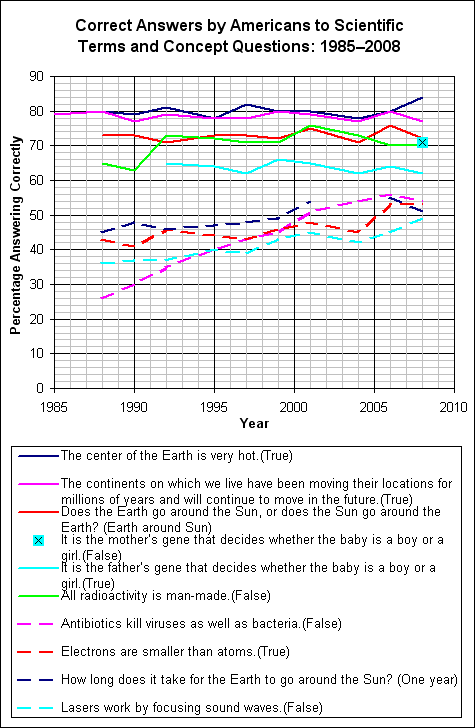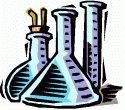Science & Engineering Indicators 2010
 It's that time again. The latest NSF report on Science and Engineering Indicators 2010 has been released (I'm actually over a month late in blogging on it, but considering that the report only comes out every two years, I figure that's not too bad). I've made previous entries for the 2004, 2006, and 2008 versions of the report. There really isn't anything new this time. The long term trends are relatively constant, and the overall literacy is still depressingly low.
It's that time again. The latest NSF report on Science and Engineering Indicators 2010 has been released (I'm actually over a month late in blogging on it, but considering that the report only comes out every two years, I figure that's not too bad). I've made previous entries for the 2004, 2006, and 2008 versions of the report. There really isn't anything new this time. The long term trends are relatively constant, and the overall literacy is still depressingly low.
First, here's the table that compares the scientific literacy of several countries. This table was taken from the section, Chapter 7. Science and Technology: Public Attitudes and Understanding. The numbers in the table are the percentage of people that responded correctly, while the correct answer is listed in parentheses after the question.
|
Figure 7-11 Correct answers to scientific literacy questions, by country/region: Most recent year (Percent answered correctly) |
||||||||
| Questions | EU-25 (2005) | Malaysia (2004) | India (2004) | China (2007) | Russia (2003) | South Korea (2004) | Japan (2001) | U.S. (2008) |
| The center of the Earth is very hot. (True) | 86 | 58 | 57 | 49 | NA | 87 | 77 | 84 |
| All radioactivity is man-made. (False) | 59 | 13 | NA | 40 | 35 | 48 | 56 | 70 |
| It is the father’s gene which decides whether the baby is a boy or a girl. (True) | 64 | 38 | 38 | 55 | 22 | 59 | 25 | 62 |
| Lasers work by focusing sound waves. (False) | 47 | 19 | NA | 20 | 24 | 31 | 28 | 49 |
| The continents have been moving their location for millions of years and will continue to move. (True) | 87 | 45 | 32 | 44 | 40 | 87 | 83 | 77 |
| Does the Earth go around the Sun, or does the Sun go around the Earth? (Earth around Sun) | 66 | 71 | 70 | 78 | NA | 86 | 72 | |
| Electrons are smaller than atoms. (True) | 46 | 26 | 30 | 22 | 44 | 46 | 30 | 53 |
| Antibiotics kill viruses as well as bacteria. (False) | 46 | 16 | 39 | 21 | 18 | 30 | 23 | 54 |
|
NA = not available, question not asked EU = European Union aChina and Europe surveys asked about “mother's gene” instead of “father's gene.” SOURCES: University of Chicago, National Opinion Research Center, General Social Survey (2008); Japan–Government of Japan, National Institute of Science and Technology Policy, Ministry of Education, Culture, Sports, Science and Technology, The 2001 Survey of Public Attitudes Toward and Understanding of Science and Technology in Japan (2002); South Korea–Korea Science Foundation, Survey of Public Attitudes Toward and Understanding of Science and Technology (2004); Russia–Gokhberg L, Shuvalova O, Russian Public Opinion of the Knowledge Economy: Science, Innovation, Information Technology and Education as Drivers of Economic Growth and Quality of Life, British Council, Russia (2004); China–Wei H, Chao Z, Hongbin G, Chinese Public Understanding of Science and Attitudes towards Science and Technology, 2007, China Research Institute for Science Popularization, Chinese Ministry of Science and Technology (2008); India–National Council of Applied Economic Research, India Science Survey (2004); Malaysia–Malaysian Science and Technology Information Centre, Public Awareness of Science and Technology Malaysia 2004 (2005); and EU–European Commission, Research Directorate-General, Eurobarometer 224/Wave 63.1: Europeans, Science and Technology (2005). Science and Engineering Indicators 2010 |
||||||||
Now, here's the table detailing the U.S. history on these questions over the past several years (with the year 1985 removed to let the table fit on this page - but don't worry, the only data from 1985 was for the question about the continents).
|
Appendix table 7-9 Correct answers to scientific terms and concept questions: 1985–2008 (Percent) |
||||||||||
| Question | 1988 n = 2,041 |
1990 n = 2,005 |
1992 n = 1,995 |
1995 n = 2,006 |
1997 n = 2,000 |
1999 n = 1,882 |
2001 n = 1,574 |
2004 n = 2,025 |
2006 n = 1,864 |
2008 n = 1,505 |
| The center of the Earth is very hot.(True) | 80 | 79 | 81 | 78 | 82 | 80 | 80 | 78 | 80 | 84 |
| The continents on which we live have been moving their locations for millions of years and will continue to move in the future.(True) | 80 | 77 | 79 | 78 | 78 | 80 | 79 | 77 | 80 | 77 |
| Does the Earth go around the Sun, or does the Sun go around the Earth? (Earth around Sun) | 73 | 73 | 71 | 73 | 73 | 72 | 75 | 71 | 76 | 72 |
| It is the mother’s gene that decides whether the baby is a boy or a girl.(False) | NA | NA | NA | NA | NA | NA | NA | NA | NA | 71a |
| It is the father’s gene that decides whether the baby is a boy or a girl.(True) | NA | NA | 65 | 64 | 62 | 66 | 65 | 62 | 64 | 62a |
| All radioactivity is man-made.(False) | 65 | 63 | 73 | 72 | 71 | 71 | 76 | 73 | 70 | 70 |
| Antibiotics kill viruses as well as bacteria.(False) | 26 | 30 | 35 | 40 | 43 | 45 | 51 | 54 | 56 | 54 |
| Electrons are smaller than atoms.(True) | 43 | 41 | 46 | 44 | 43 | 46 | 48 | 45 | 53 | 53 |
| How long does it take for the Earth to go around the Sun? (One year) | 45 | 48 | 46 | 47 | 48 | 49 | 54 | NA | 55 | 51 |
| Lasers work by focusing sound waves.(False) | 36 | 37 | 37 | 40 | 39 | 43 | 45 | 42 | 45 | 49 |
|
NA = not available, question not asked aQuestion about "father's gene" asked of 1,251 survey respondents. Question about "mother's gene" asked of 254 survey respondents. NOTES: Table includes all years for which data collected. "Don't know" responses and refusals to respond counted as incorrect. SOURCES: National Science Foundation, Division of Science Resources Statistics, Survey of Public Attitudes Toward and Understanding of Science and Technology (1985–2001); University of Michigan, Survey of Consumer Attitudes (2004); and University of Chicago, National Opinion Research Center, General Social Survey (2006, 2008). Science and Engineering Indicators 2010 |
||||||||||
And for something new compared to my previous blog entries on the science and engineering indicators, here's a graph of the above data to make it easier to see the trends.

Just look at those results - around a quarter of Americans think that the Sun goes around the Earth, half don't realize that electrons are smaller than atoms, and half don't know that it takes a year for the Earth to go around the Sun! Keep that in mind whenever you hear people citing public opinion polls on the validity of concepts like global warming or evolution.
It's always a bit depressing to see those numbers. It's hard to believe that the people of our nation are so ignorant. If there's one lesson to take away from these results, it's that we need to vastly improve our education system.
Update 2010-02-26: I updated the graph to add a title and labels to the axes. Also, the night after I wrote this entry, I went home and asked my 10 year old daughter the questions from the survey. She managed to get 9 out of 10 correct.

 As evidenced by one of my
As evidenced by one of my  When I tell people from outside Texas what a bad board of education we have, I don't think they realize just how bad it is. They seem to think it's the general complaints about governments that everybody has. But the board of education down here really is horrible. I've blogged previously about the
When I tell people from outside Texas what a bad board of education we have, I don't think they realize just how bad it is. They seem to think it's the general complaints about governments that everybody has. But the board of education down here really is horrible. I've blogged previously about the  Depending on where you are in the world, you may call tomorrow something else, like Mardi Gras, Shrove Tuesday, or Pancake Day. But from where I'm from in Pennsylvania, it's called Fastnacht Day. Traditionally, you make potato based donuts, called fastnachts, supposedly as a way to empty your larder of all the fatty, sugary foods in preparation for the Lenten fast. My elementary school even used to give out donuts with the lunches on this day. So, in celebration of Fastnachts, here's
Depending on where you are in the world, you may call tomorrow something else, like Mardi Gras, Shrove Tuesday, or Pancake Day. But from where I'm from in Pennsylvania, it's called Fastnacht Day. Traditionally, you make potato based donuts, called fastnachts, supposedly as a way to empty your larder of all the fatty, sugary foods in preparation for the Lenten fast. My elementary school even used to give out donuts with the lunches on this day. So, in celebration of Fastnachts, here's